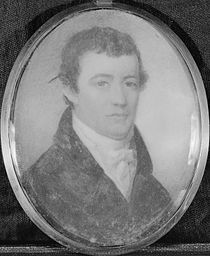Elias Horry
Elias Horry | |
|---|---|
 | |
| 22nd Mayor of Charleston | |
| In office 1815–1817 | |
| Preceded by | Thomas Rhett Smith |
| Succeeded by | John Geddes |
| In office 1820–1821 | |
| Preceded by | Daniel Stevens |
| Succeeded by | James Hamilton, Jr. |
| Personal details | |
| Born | June 21, 1773 Charleston, South Carolina |
| Died | September 17, 1834 Charleston, South Carolina |
| Spouse(s) | Harriet Vanderhorst (m. 1797); Mary R. Shubrick (m. 1817) |
| Children | Thomas Lynch Horry (1806–1871); Harriet Vanderhorst Horry Frost (1807–1890); Ann Branford Horry (1812–1824); Elias Horry (1815–1817); Alicia Mary Horry (1820–1826); Elias Horry (1822–1839); Richard Shubrick Horry (1823–1824) |
| Profession | Lawyer |

Elias Horry was the twenty-second intendant (mayor) of Charleston, South Carolina, serving two terms from 1815 to 1817.
Horry was elected warden (city council member) in September 1813 before becoming the interim intendant (mayor) on March 30, 1815, after Thomas Rhett Smith resigned.[1] On September 18, 1815, he was elected to a full term and then re-elected September 16, 1816,[2] defeating Daniel Stevens.[3] After four terms by two other mayors, he returned to the position after having been elected on September 4, 1820 for one more term.[4]
Horry was born in 1773, educated locally, and joined Charles Cotesworth Pinckney's office as a law student.[5] In 1793, he was admitted to the South Carolina bar. Horry represented St. James, Santee, in South Carolina General Assembly from 1794 to 1804. Many years later, he served as a representative of the Charleston area from 1830 to 1833. He died on September 17, 1834. He is buried at the Cathedral of St. Luke and St. Paul in Charleston, South Carolina.[4][6]
Horry owned several plantations including the following: The Bluff, Wattahan, Milldam, Jutland, Camp Main, Camp Island, Newland, Midland and Millbrook plantations (Santee River) in Georgetown District and St. James, Santee, Parish.[4]
Horry became president of the South Carolina Canal and Railroad Company in 1831.[7]
References
- ^ "Elias Horry, Esq. . . ". City Gazette and Daily Advertiser. Charleston, South Carolina. April 1, 1815. p. 3. Retrieved January 25, 2014.
- ^ "Elias Horry, Esq. . . ". City Gazette and Daily Advertiser. Charleston, South Carolina. September 17, 1816. p. 2. Retrieved January 25, 2014.
- ^ "An election for Intendant . . ". City Gazette and Daily Advertiser. Charleston, South Carolina. September 16, 1816. p. 2. Retrieved January 25, 2014.
- ^ a b c "Elias Horry". Preservation Society of Charleston. Archived from the original on February 2, 2014. Retrieved January 25, 2014.
{{cite web}}: Unknown parameter|deadurl=ignored (|url-status=suggested) (help) - ^ "At a quarterly meeting . . ". The Southern Patriot. Charleston, South Carolina. October 17, 1834. p. 2. Retrieved January 25, 2014.
- ^ "Elias Horry (1773-1834)". Find a Grave. Retrieved January 25, 2014.
- ^ Smith, Alice R. Huger; Smith, D.E. Huger (2007). The Dwelling Houses of Charleston. Charleston: The History Press. p. 60. ISBN 9781596292611.
